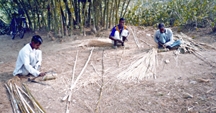Gharami
Gharami specialised people who make the ghar or traditional house, especially mud houses. In the north and northeastern and northwestern parts of Bangladesh, which are above normal flood level, houses are traditionally made of mud. The walls are built with processed mud and cow-dung. The alternative to mud walls is bamboo wall. The thick bamboo is split into plates, which are sewn into a strong fence. The roofs are thatched with bamboo reeds, rank grasses, and straw and corrugated iron. All these mud and bamboo houses have distinctive architectural styles. A professional class of artisans called gharami makes these houses.

Once upon a time, to be a gharami artisan was a hereditary calling, but now hereditary gharamis are declining. The main reason is shift of rural architecture from traditional to modern pucca or semi pucca houses. Traditional gharamis made houses of various sizes and designs. The most famous houses, which show both art and lavishness, are the atchala (eight fold thatch roofs) supported by decorated walls and partitions made variously of bamboo reeds, cane and rank grass. Gharamis also make chowchala, duchala an ekchala ghars or houses. In elegance, next to atchala is the chowchala ghar. These houses are now becoming rare and with that the class of gharami who once commanded considerable respect as rural architects is also fast withering. [Gofran Faroqi]
